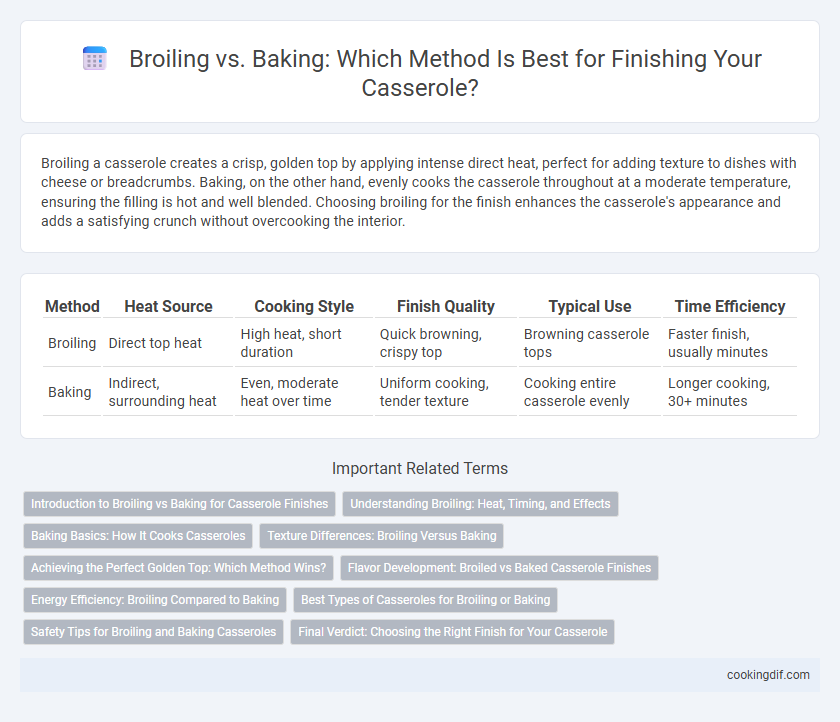Broiling a casserole creates a crisp, golden top by applying intense direct heat, perfect for adding texture to dishes with cheese or breadcrumbs. Baking, on the other hand, evenly cooks the casserole throughout at a moderate temperature, ensuring the filling is hot and well blended. Choosing broiling for the finish enhances the casserole's appearance and adds a satisfying crunch without overcooking the interior.
Table of Comparison
| Method | Heat Source | Cooking Style | Finish Quality | Typical Use | Time Efficiency |
|---|---|---|---|---|---|
| Broiling | Direct top heat | High heat, short duration | Quick browning, crispy top | Browning casserole tops | Faster finish, usually minutes |
| Baking | Indirect, surrounding heat | Even, moderate heat over time | Uniform cooking, tender texture | Cooking entire casserole evenly | Longer cooking, 30+ minutes |
Introduction to Broiling vs Baking for Casserole Finishes
Broiling exposes casseroles to direct high heat from above, creating a crisp, browned topping ideal for gratins or cheese finishes. Baking surrounds the casserole with even, consistent heat, ensuring thorough cooking and moisture retention throughout the dish. Choosing broiling or baking affects texture and flavor intensity, with broiling offering a fast, caramelized finish and baking providing gentle, uniform doneness.
Understanding Broiling: Heat, Timing, and Effects
Broiling applies intense, direct heat from above, rapidly crisping the casserole's surface while maintaining moisture inside. This method requires careful timing, typically a few minutes under a high-temperature broiler to achieve a golden-brown, bubbly finish without burning. Understanding broiling's heat distribution helps enhance texture and presentation, distinguishing it from the even, slower cooking process of baking.
Baking Basics: How It Cooks Casseroles
Baking cooks casseroles evenly by surrounding them with consistent, dry heat in an oven, ensuring thorough cooking of ingredients and a tender texture. The slow, steady heat allows for flavors to meld and the dish to set properly without burning the surface. Broiling, by contrast, applies intense direct heat from above, primarily used to brown or crisp the casserole's topping quickly after baking.
Texture Differences: Broiling Versus Baking
Broiling casseroles creates a crispy, golden-brown crust by exposing the top layer to high, direct heat, enhancing texture contrast between the crunchy top and tender interior. Baking cooks casseroles evenly at moderate temperatures, resulting in a uniformly soft texture with a gently browned surface. Choosing broiling focuses on achieving a crisp, caramelized finish, while baking emphasizes consistent tenderness throughout the dish.
Achieving the Perfect Golden Top: Which Method Wins?
Broiling creates an intense, direct heat that crisps the casserole's surface quickly, ideal for achieving a golden, bubbly top. Baking evenly cooks the entire dish at moderate heat, ensuring a tender interior but a less browned crust. For the perfect golden finish, broiling for the last 3-5 minutes offers superior results compared to baking alone.
Flavor Development: Broiled vs Baked Casserole Finishes
Broiling a casserole intensifies flavor development by rapidly caramelizing the top layer, creating a crisp, golden crust rich in Maillard reaction notes. Baking provides a more uniform heat, allowing flavors to meld gradually while maintaining a tender, moist interior without over-browning. Choosing broiling for the finish enhances depth and texture contrast, whereas baking ensures even doneness and subtle flavor integration throughout.
Energy Efficiency: Broiling Compared to Baking
Broiling a casserole uses intense, direct heat from above, which cooks food faster and typically consumes less energy compared to baking, where heat surrounds the dish evenly for a longer period. Baking generally requires the oven to operate at moderate temperatures for extended times, leading to higher energy use. Choosing broiling for finishing casseroles can reduce cooking time and energy consumption while achieving a crisp surface texture.
Best Types of Casseroles for Broiling or Baking
Broiling is ideal for casseroles with cheese toppings, like lasagna or macaroni and cheese, as it creates a golden, crispy crust while baking suits dense, layered casseroles such as shepherd's pie or tuna noodle casserole, allowing even cooking throughout. Broiling works best with thinner, moisture-rich casseroles that benefit from quick, high heat to caramelize the surface, whereas baking is preferred for casseroles containing starchy ingredients or those that require slow, thorough cooking. When selecting a casserole type, consider broiling for dishes with delicate toppings or gratins, and baking for robust, hearty casseroles where heat must penetrate evenly.
Safety Tips for Broiling and Baking Casseroles
Broiling casseroles requires careful attention to avoid burns and overheating, so always use oven mitts and keep a close watch to prevent food from charring. Baking casseroles demands preheating the oven to a consistent temperature and placing the dish in the center rack to ensure even cooking and avoid undercooked spots. Use oven-safe cookware with sturdy handles tailored for high heat to enhance safety during both broiling and baking processes.
Final Verdict: Choosing the Right Finish for Your Casserole
Broiling adds a crispy, golden top to casseroles, enhancing texture and visual appeal, while baking ensures even cooking and a tender interior. The choice depends on desired texture; broil for a crunchy finish or bake for thorough, consistent heat distribution. For best results, bake the casserole fully and finish under the broiler to achieve a balanced combination of moist filling and crisp topping.
Broiling vs baking for casserole finish Infographic

 cookingdif.com
cookingdif.com